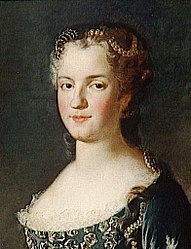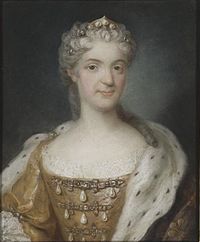Frison (hairdresser)
Frison (* around 1700, † in the 18th century) was in the time of King Louis XV. worked as a hairdresser in Paris . He was the court hairdresser of Queen Maria Leszczyńska and is considered the first prominent ladies' hairdresser in France.
Life
Up until the beginning of the 18th century, the hairdressing profession was unknown in France. In better society the gentlemen were coiffed by their valets, and the ladies of society entrusted their heads to the chambermaids. The common people were dependent on the services of barbers and wig makers. At the beginning of the 18th century, male master wig makers took over the hairdressing of women in opera houses, a first step on the way to becoming a ladies' hairdresser.
In this situation, the former lackey Frison took the stage, the first prominent ladies' hairdresser of the 18th century, who delighted women with the elegance of his hairstyles. The evocative name Frison ("little curl") was not his real name, rather he owed this nickname to the women who pay homage to him. In a pamphlet between wigmakers and hairdressers it is said that "Dubois called Frison" and Dagé were well known as "the hairdresser of the queen and the ladies of the court". The common name Dubois is not very helpful in the search for the sparse traces of the master hairdresser, so that his origin and his detailed biography must remain in the dark.
Court hairdresser
Madame de Cursay discovered Frison's talent and recommended him to her sister-in-law, Madame de Prie . She was the mistress of the Duke of Bourbon and during his tenure as Prime Minister the actual regent of France. She threaded the marriage of Louis XV. with the Polish Princess Maria Leszczyńska , which took place in 1725. Through the mediation of Madame de Prie, Frison became the queen's hairdresser and thus made his breakthrough as the fashion hairdresser of society's women.
Frison's low, forehead-free, curly hairstyles lay close to the head, sometimes complemented by hanging side curls. Feathers, diamonds and caps served as decorative accessories.
Apparently Frison had already been forgotten in 1770. In the memoirs of Mademoiselle Quinault, the author poses the rhetorical question:
- “Who, Frison? one would ask today (in the year 1770). - Oh, that was this fashion hairdresser, a former lackey, a handsome young man with skilled hands and exquisite taste. He succeeded in gaining a terrific reputation, the ladies at court only wanted to be groomed by him; and the ladies in town had to pay up to six louis dor per meeting if they wanted him. "
Marquise d'Herbault
When the finance minister Charles Gaspard Dodun was appointed Marquis in 1723, a mocking poem arose that poked fun at the conceit of his wife Marie-Anne Dodun, now Marquise d'Herbault:
La Dodun dit à Frison:
Coiffez-moi avec adresse,
Je prétends avec raison
Inspirer de la tendresse.
Tignonnez, tignonnez, bichonnez-moi,
Je vaux bien une duchesse,
Tignonnez, tignonnez, bichonnez-moi.
Je vais souper chez le roi!Mrs. Dodun said to Frison:
Do my hair skillfully,
it is undoubtedly certain
that I tempt you to tenderness.
Braid, braid, decorate my hair,
I am worth as much as a duchess,
braid, braid, decorate my hair,
I will have dinner with the king!
Guigne, the king's barber
The professional colleagues Frisons saw the rise of the lateral entrant with great jealousy. The Goncourt brothers reported in their 1862 monograph on women in the 18th century:
- “And this Frison, who did not train students, aroused envy everywhere. Guigne, the king's hairdresser, disguised himself as a lackey to spy on Frison at work. However, Frison, who recognized him, duped him and haired his customer as badly as he could. "
An early nineteenth-century memoir writer, Étienne-Léon de Lamothe-Langon, even liked to accuse the royal barber with murderous intentions:
- Frison “could easily have ousted the famous Guigne, the king's barber, from the throne. … Guigne became so desperate about this that, in his madness, he armed himself with a pistol and a razor to kill his rival. You had to use force to prevent him from doing his job, lock him up and give him cold showers. "
successor
Frison was one of the first prominent ladies' hairdressers in France. The Queen, his main customer, died in 1768, when Frison died is not known. Dagé belonged to the next generation of star hairdressers. He counted two mistresses of Louis XV. to his customers: the Duchess of Châteauroux and Madame de Pompadour . The next generation of star hairdressers included Legros de Rumigny , author of a hairstyle book and founder of a hairdressing academy, and the hairdressers of Queen Marie-Antoinette , Larseneur and his successor Léonard Autié . Autié and the milliner Rose Bertin , one of the few prominent hairdressers, were best known for their tower hairstyles.
literature
Life
- Edmond et Jules de Goncourt : La femme au dix-huitieme siecle. Paris: Firmin Diderot, 1862, pp. 303-304, pdf .
- Étienne-Léon de Lamothe-Langon: Mémoires de Mademoiselle Quinault ainée, Volume 2. Paris: Allardin, 1836, pages 130-131, pdf .
- Marie de Villermont: Histoire de la coiffure féminine. Brussels: Ad. Mertens, 1891, pages 680-681, pdf .
Others
- MW Duckett (editor): Dictionnaire de la conversation et de la lecture: inventaire raisonné des notions générales les plus indispensables à tous, par une société de savants et de gens de lettres, Seconde Édition, Tome 6. Paris, 1867, page 1– 2, pdf .
- Joly de Fleury: Responses aux objections pour les coëffeurs des dames contre les Maîtres Barbiers & Perruquiers. Paris: Knapen & Delaguette, 1769, pdf .
Web links
Footnotes
- ↑ #Duckett 1867 , page 1.
- ↑ #Fleury 1769 , page 3.
- ↑ # Lamothe-Langon 1836 , page 130.
- ↑ #Fleury 1769 , page 3.
- ↑ At Madame de Cursay: [1] .
- ↑ #Goncourt 1862 , page 303.
- ↑ #Goncourt 1862 , pp. 304-305.
- ↑ # Lamothe-Langon 1836 , page 130.
- ↑ #Goncourt 1862 , pp. 303-304.
- ↑ #Goncourt 1862 , p. 304.
- ↑ # Lamothe-Langon 1836 , pp. 130-131.
| personal data | |
|---|---|
| SURNAME | Frison |
| BRIEF DESCRIPTION | French hairdresser in the time of King Louis XV. |
| DATE OF BIRTH | around 1700 |
| DATE OF DEATH | 18th century |




